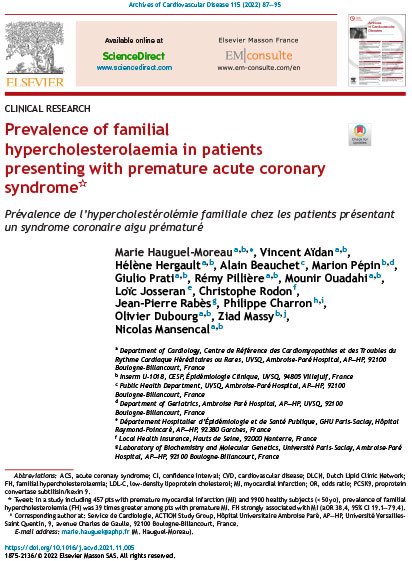
Archives of Cardiovascular Diseases
Article du mois - Février 2022
Prévalence de l’hypercholestérolémie familiale chez les patients présentant un syndrome coronaire aigu prématuré
Marie Hauguel-Moreau, Vincent Aïdan, Hélène Hergault, Alain Beauchet, Marion Pépin, Giulio Prati, Rémy Pillière, Mounir Ouadahi, Loïc Josseran, Christophe Rodon, Jean-Pierre Rabès, Philippe Charron, Olivier Dubourg, Ziad Massy, Nicolas Mansencal
Summary
Background. — Familial hypercholesterolaemia (FH) is responsible for severe hypercholesterolaemia and premature cardiovascular morbidity and mortality. The first clinical event is typically an acute coronary syndrome. Unfortunately, FH is largely underdiagnosed in the general population.
Aims. — To assess the prevalence of clinical FH among patients with premature (aged ≤ 50 years) acute myocardial infarction (MI) and compare it with FH prevalence in a control population.
Methods. — We reviewed in our database all patients with premature MI (aged ≤ 50 years) referred to Ambroise Paré Hospital from 2014 to 2018. FH prevalence was estimated via the Dutch Lipid Clinic Network score, based on personal and family history of premature cardiovascular disease and low-density lipoprotein cholesterol concentrations. FH was ‘‘possible’’ with a score between 3 and 5 points, ‘‘probable’’ with a score between 6 and 8 and ‘‘definite’’ with a score above 8. FH prevalence in young patients with MI was then compared with FH prevalence in a general population of the same age from the CARVAR 92 prospective cohort.
Results. — Of the 457 patients with premature MI, 29 (6%) had ‘‘probable’’ or ‘‘definite’’ FH. In the CARVAR 92 cohort, 16 (0.16%) of 9900 subjects aged ≤ 50 years had ‘‘probable’’ or ‘‘definite’’ FH. FH prevalence was 39 times greater among patients with premature MI than in the control population (P < 0.0001). In multivariable analysis, FH was strongly associated with MI (adjusted odds ratio 38.4, 95% confidence interval 19.1—79.4).
Conclusions. — FH is > 30-fold more common in patients referred for premature MI than in the general population; this highlights the need for FH screening after a first MI to enhance lipid lowering therapy and allow early identification of family members.